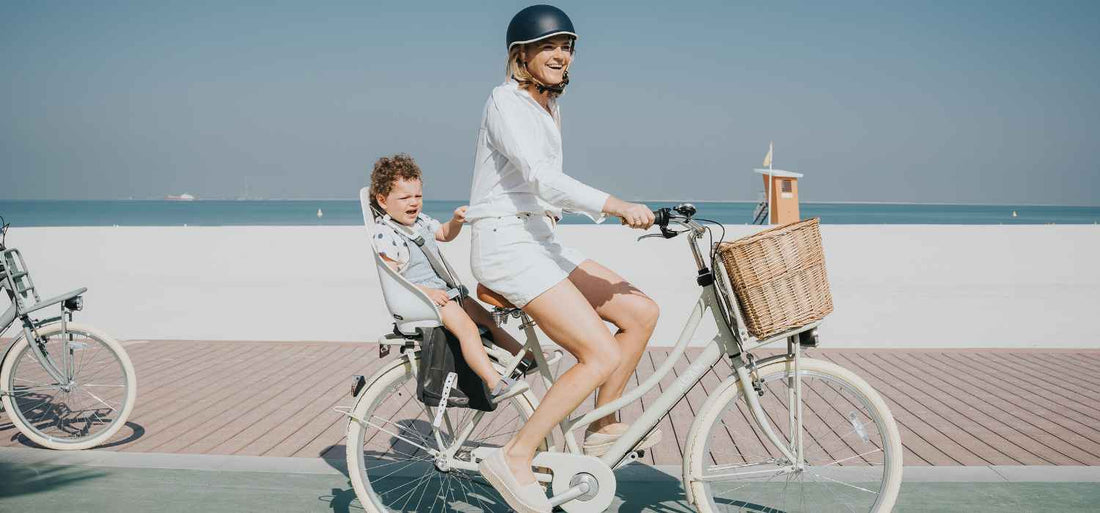
Can You Ride a Bicycle on the Sidewalk in Dubai?
Share
Have you ever wondered whether it's legal to ride your bicycle on Dubai's sidewalks? With the city's rapid development of cycling infrastructure, it's important to know where you can and can't ride. In this article, we'll explore the ins and outs of cycling in Dubai to help you stay on the right side of the law.
Is It Legal to Ride on Sidewalks in Dubai?
The legality of riding a bicycle on the sidewalk in Dubai is clear: it is generally prohibited. Dubai's Roads and Transport Authority (RTA) regulations state that cyclists must use dedicated cycle tracks where available. In areas without cycle tracks, cyclists are permitted to use the road but not the sidewalk. This regulation is strictly enforced, especially in busy urban areas and tourist destinations.
Dubai has invested heavily in creating dedicated cycling infrastructure, with over 1,000 kilometers of cycle tracks built across the emirate by 2023. These purpose-built tracks provide a safer, more enjoyable alternative to road and sidewalk riding, encouraging more residents and visitors to embrace cycling as part of their daily lifestyle.
What Are the Age Restrictions for Cycling in Dubai?
In Dubai, children under 12 years old must be supervised by an adult when cycling on public roads or dedicated cycling tracks. While there isn't a specific exemption allowing children to use sidewalks, greater leniency may be shown toward very young cyclists in residential areas.
The RTA strongly recommends that children practice cycling in parks, dedicated cycling tracks, or other recreational areas rather than on roads or sidewalks. If you're looking for the perfect beginner's ride, check out our kids bicycles collection, designed for young riders of all ages.
Do Cyclists Yield to Pedestrians in Dubai?
Absolutely. When cycling anywhere in Dubai, cyclists must yield the right of way to pedestrians. This is particularly important at crossings and in shared spaces. Safety is paramount in Dubai, and respecting pedestrian space helps prevent accidents and supports Dubai's vision of becoming a bicycle-friendly city.
Parents transporting younger children can also make use of our safe and comfortable child seats, ensuring both you and your child ride responsibly and securely.
Where Can You Ride a Bike Legally in Dubai?
In Dubai, you can legally ride your bicycle in several areas designed for both safety and enjoyment:
● Dedicated cycle tracks (found in locations like Dubai Marina, Jumeirah Beach Residence, Al Qudra, Nad Al Sheba, and more)
● Roads where cycling is permitted, avoiding major highways and expressways
● Designated cycling parks such as Mushrif Park and Al Qudra Cycling Track or Al Barsh Pond Park
● Desert cycling tracks like the Al Qudra Cycle Path, offering routes of varying distances
● Family-friendly communities such as Sustainable City, The Springs, The Meadows, Arabian Ranches, and Villa Nova, where many families live. These neighborhoods offer safe, enclosed environments perfect for kids and adults to cycle freely, enjoying fresh air and exercise without worrying about heavy traffic.
If you’re planning longer trips or need extra storage space, an electric cargo bike provides the perfect balance of practicality and fun, fully compliant with Dubai’s cycling laws when used correctly.
Dubai's Cycling Regulations
Dubai has specific regulations for cyclists:
● Wearing a helmet is mandatory—explore our range of adult helmets for safe riding.
● Reflective clothing is required when cycling at night
● Bicycles must be equipped with front and rear lights
● Cyclists must adhere to all traffic signals and signs
● Cycling against the flow of traffic is prohibited
● Cyclists must maintain a safe distance from vehicles and pedestrians
Fines for violations range from AED 200-300 depending on the offense. Regular bicycle maintenance is also key to ensuring your bike is compliant and road-ready.
Are Electric Bicycles Allowed in Dubai?
Electric bicycles are permitted in Dubai but face additional regulations. They:
● Must not exceed a top speed of 25 km/h
● Require registration with the RTA if used on roads
● Cannot be used on sidewalks under any circumstances
● Must be used on cycle tracks where available
The RTA and Dubai Police frequently run awareness campaigns to ensure riders of electric bikes understand these guidelines.
Dubai's Ambitious Cycling Vision
Dubai is on a transformative journey to establish itself as the world’s premier cycling-friendly city by 2040. Central to this goal is the Dubai Cycle City 2040 initiative, which aims to expand the city’s cycling network to over 1,000 kilometers, positioning Dubai alongside renowned cycling cities like Amsterdam and Copenhagen. One of the flagship projects is THE LOOP, a 93-kilometer climate-controlled cycling highway designed to connect more than three million residents to key destinations, encouraging cycling and walking as primary modes of transport.
At The Adam Store, we share this vision by offering classic Dutch-style bicycles—perfect for enjoying Dubai’s growing network of safe, accessible cycling routes. Whether you're commuting or riding leisurely, our bikes fit seamlessly into the city's evolving cycling culture.
Conclusion
Understanding where you can legally cycle in Dubai is essential for both safety and avoiding fines. As Dubai continues to expand its cycling infrastructure, riding becomes increasingly accessible for everyone.
For a safe, enjoyable cycling experience, always check the RTA website for current regulations, use the dedicated cycling tracks, and keep your bicycle well-maintained. At The Adam Store, we’re here to support your journey—whether you need a new adult bicycle, safety gear, or bike accessories.
FAQs
1. Why are bicycles not designed for sidewalk use in Dubai?
Sidewalks in Dubai are often narrower, designed for pedestrian flow, and may have uneven surfaces, making them unsuitable and unsafe for bicycles. Additionally, obstacles like street furniture and retail stands increase accident risk.
2. Are delivery cyclists allowed to ride on the sidewalk in Dubai?
No, delivery cyclists, including those working for courier services or food delivery, must also adhere to Dubai’s traffic laws and use bike lanes or roads—not sidewalks. Violating this can result in fines and penalties.
3. What alternatives are available if cyclists can’t use the sidewalk in crowded areas?
Dubai offers multiple cycling tracks, service lanes, and community parks that are safer alternatives. Areas like Nad Al Sheba, Al Qudra, and Jumeirah Open Beach have dedicated bike-friendly zones, providing safer options for all riders.
4. How do Dubai’s sidewalk cycling rules compare to other cities in the UAE?
While Dubai strictly enforces no cycling on sidewalks, smaller cities or residential communities in the UAE might have more relaxed enforcement. However, most major urban centers follow Dubai's model prioritizing pedestrian safety.
5. Is there any special signage in Dubai indicating where bicycles can or cannot ride?
Yes, Dubai uses clear signage for cycle tracks, shared lanes, and pedestrian-only areas. Cyclists should always watch for signs showing bike lane symbols or “No Cycling” warnings to avoid mistakenly riding in prohibited zones like sidewalks.
6. Where can beginners learn to ride a bicycle safely in Dubai?
If you’re new to cycling or want to build confidence before riding on Dubai’s dedicated tracks, we’ve partnered with Go with the Flow to offer cycling lessons for all ages. These sessions are perfect for learning basic skills, improving balance, and understanding safe riding practices—all while enjoying Dubai’s growing cycling culture. Contact us to learn more about how to sign up for a lesson and get comfortable on two wheels!
